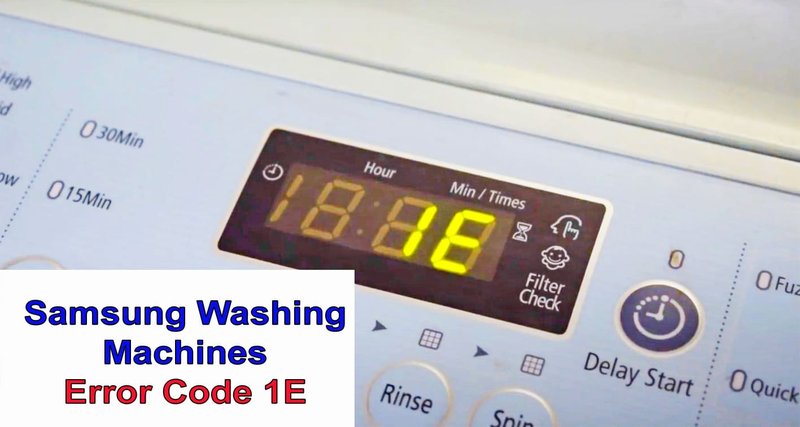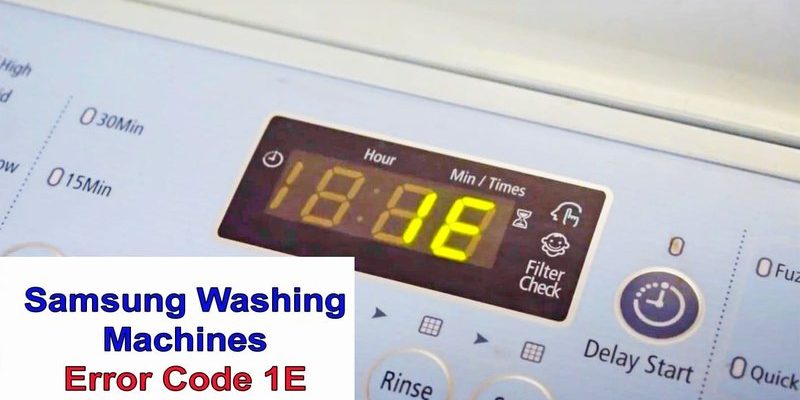
The E1 error on Samsung washing machines is like your washer’s way of waving a little red flag to say, “Hey, something’s not right with the water supply!” Your washer needs water to function correctly, just like we need water to stay hydrated. If there’s a glitch in its water system, it can’t do its job, which means your clothes stay dirty, and nobody wants that.
Ignoring this error is akin to ignoring a flashing check engine light in your car. It might seem fine at first, but sooner or later, that small problem could cause a bigger mess. To help you understand, let’s delve a bit deeper into what this error is all about, why it happens, and what could go wrong if it’s left unattended.
Understanding the Samsung Error E1
When your Samsung washing machine displays an E1 error, it’s primarily indicating problems with the water supply system. Think of it as the washing machine’s way of saying, “I’m not getting enough water to wash your clothes.” This could be due to several reasons, which we’ll explore.
Water flow is crucial for a washing machine to perform a complete cycle. The E1 error suggests that the water isn’t filling up the machine as it should. Imagine trying to fill a bathtub, but the faucet is only dripping — that’s essentially what’s happening inside your washer.
Several culprits could lead to this error. It might be as simple as the water tap not being fully open, or perhaps a kink in the hose. Worse yet, it could be a more complex issue like a malfunctioning inlet valve. The inlet valve, which acts like a bridge for water to enter your machine, might be blocked or defective, similar to a clogged water pipe. Understanding these potential causes is crucial in tackling the E1 problem efficiently.
The Consequences of Ignoring the E1 Error
So, what if you decide to cross your fingers and let the E1 error slide? Ignoring this error might seem harmless initially, but it’s a bit like ignoring a slow leak in a balloon. Eventually, you’re going to have a problem that’s much more significant.
First off, your washing machine will simply stop working as intended. Without adequate water, it can’t soak, rinse, or clean your laundry. This means those piles of dirty clothes will keep piling up, and you’ll be stuck hand-washing or visiting laundromats, which can be inconvenient and costly. Over time, continuously operating the washer under stress might wear out other components, leading to more extensive and expensive repairs.
Moreover, if the inlet valve is faulty, it might cause water leaks. Imagine leaving a dripping tap unattended; it could gradually turn into a full-blown leak, causing water damage to your laundry room or basement. This isn’t just about extra cleaning and repairs — it’s a potential hazard that could lead to slippery floors or mold growth.
Addressing the E1 Error: Practical Solutions
Now, let’s talk about tackling the E1 error head-on. First, ensure your water supply tap is fully open. It might seem obvious, but sometimes, the simplest solutions are the most effective. Ensure there are no kinks or blockages in your water hose — it should be as clear as an open freeway.
If basic checks don’t resolve the issue, inspect the water inlet valve. This component is like the gatekeeper for water in your machine. Ensure it’s clean and operational. Replacing it might be necessary if it’s malfunctioning. While this might sound daunting, think of it like changing a light bulb — a small fix with a big impact.
Should the problem persist, don’t shy away from calling a professional. It’s like taking your car to a mechanic when it starts making that worrisome noise. A technician can quickly determine the issue and prevent any future headaches.
Preventative Measures and Final Thoughts
The best way to avoid the E1 error is through prevention. Regular maintenance of your washing machine is key. Just like how we schedule regular check-ups at the doctor, your washer needs occasional attention. Check hoses and valves periodically for wear and tear, and clean filters regularly to ensure smooth operation.
Also, consider the placement of your machine. Ensure it’s level and stable; vibrations or misalignment can sometimes loosen connections over time. These are small steps, but they can significantly prolong your washer’s life and save you from future troubles.
In conclusion, while the E1 error might seem like just a minor annoyance, it’s a clear signal from your washing machine that it needs some attention. By addressing it head-on with the steps outlined, you’ll ensure that your washing machine runs efficiently and keeps your laundry day stress-free. If you notice this error, take action promptly, and you’ll prevent a small hiccup from becoming a giant headache. Remember, a little maintenance today keeps the repairman away tomorrow!
